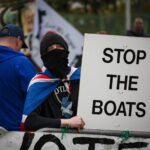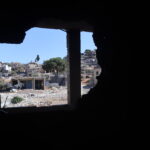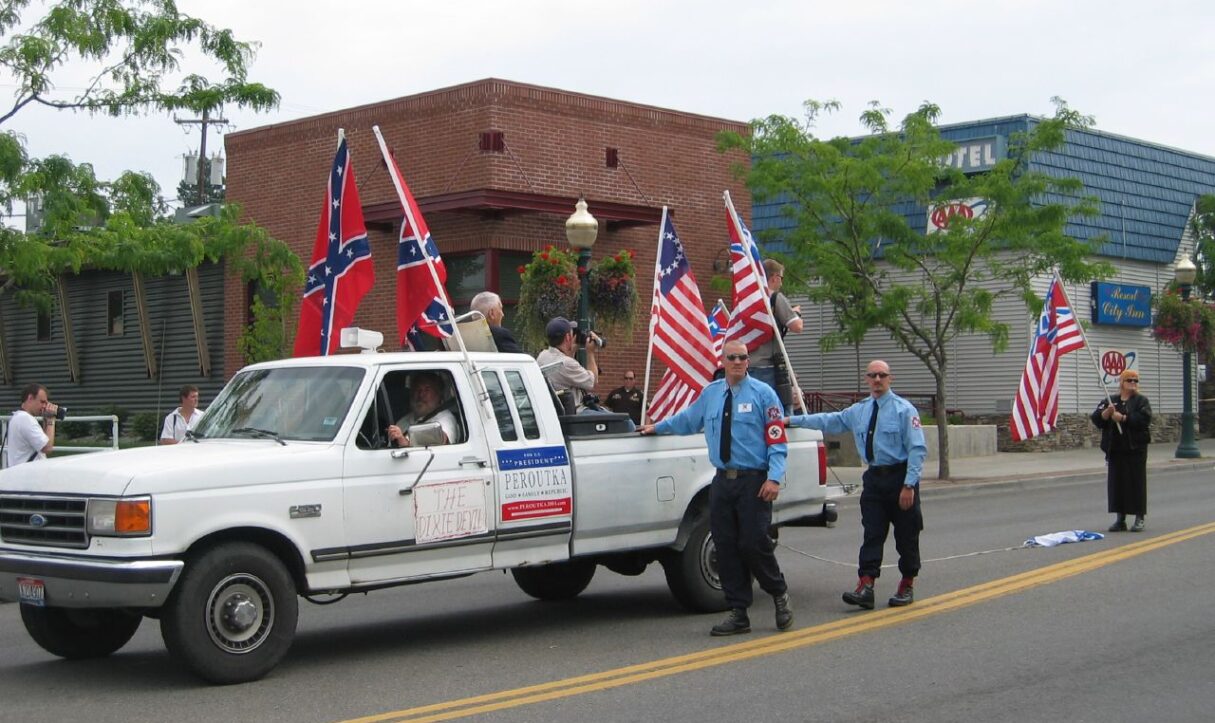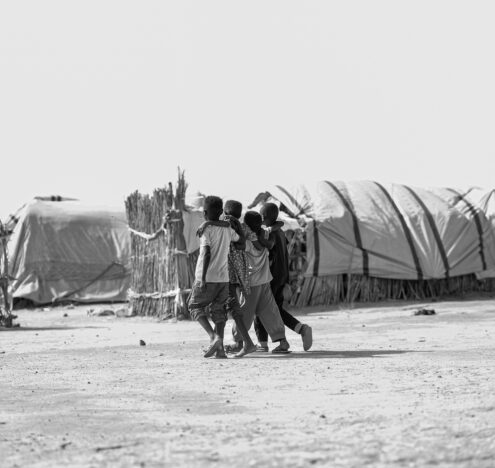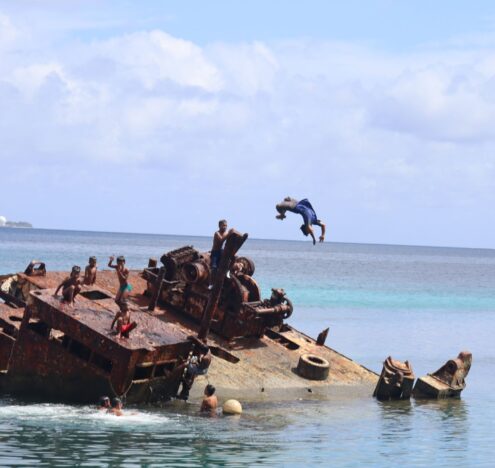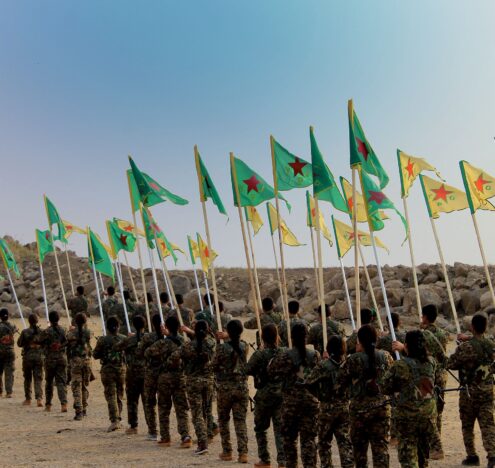How does a terrorist campaign end? Justin Kurzel’s latest film, The Order, doesn’t explicitly address this enduring subject of debate — but perhaps it should have. As many viewers learn about the real-world Order’s reign of terror for the first time, the film provides a timely opportunity to reflect on what it takes to address the rising threat of political violence and extremism in the United States.
Centered around the group’s charismatic leader, Robert Jay Mathews (Nicholas Hoult), The Order powerfully captures the rapid ascent and abrupt demise of one of the most dangerous domestic terror groups of the last century. In just over a year, the Order conducted a string of targeted attacks and armed robberies, accumulating a war chest of millions of dollars. Tightly focused on the group’s activities between late 1983 and December 1984, however, the film ultimately undersells the lasting legacy of Mathews’s terror network.
As other writers and critics have noted, The Order’s intense pace evokes the classic crime thrillers of the late twentieth century — most notably Michael Mann’s Heat. Yet, whereas its predecessors are defined by their depiction of the American city, The Order stands out for its dramatic presentation of the Pacific Northwestern landscape. The film no doubt draws on familiar crime drama tropes, including that of the grizzled veteran investigator and the untested rookie.
Jude Law nonetheless delivers a strong performance as FBI special agent Terry Husk, a fictional composite of the many law enforcement officers who worked the real case against the Order. Scenes recreating the Order’s armed robberies place the plot in a long lineage of heist classics. Indeed, Law’s first encounter with masked thieves mirrors a particularly memorable confrontation in The Town.
Violent Infighting
Beyond its cinematic value, The Order effectively captures many of the broad themes and tensions present in the white supremacist extremist movement, both then and now. The film opens with a depiction of internecine violence perpetrated by members of the Order against one of their own — a suspected informant. The scene is representative of frequent (and often deadly) infighting among white supremacists.
Tightly focused on the group’s activities between late 1983 and December 1984, however, the film ultimately undersells the lasting legacy of Mathews’s terror network.
The Order likewise features internal debates about the value of terrorist violence in contrast to advancing movement objectives by co-opting existing political institutions. Mathews and Aryan Nations founder Richard Butler (Victor Slezak) serve as proxies for each side of the conflict in the film, but these disputes about tactics and optics occurred even more broadly in real life. This internal choice also fed division among prominent movement figures such as National Alliance founder William Luther Pierce and Klan leader Louis Beam, and the topic remains a point of contention decades later.
Motivation and Makeup
Perhaps more subtly, The Order also has something to say about the motivation and makeup of white supremacist movements. Though Mathews’s rhetoric throughout the film is defined by grievances related to status decline and economic dislocation, Kurzel pointedly depicts the family of prominent Order ideologue David Lane as polished and affluent. The brief scene seems to serve as a nod to the reality that white-collar workers, business owners, and well-educated professionals have always played a key role in American white supremacist movements.
Despite these strengths, the film’s characterization of Mathews’s wife, Debbie, obscures her individual participation in the movement and also belies the broader role of women in the white power scene. In contrast to her depiction as exhausted by her husband’s infidelity and reluctant to support his violence, Debbie Mathews ultimately “rose to prominence” in the movement, according to historian Kathleen Belew. In Bring the War Home, Belew describes how Debbie “became a regular speaker at white power events as the honored widow of Bob Mathews after his death.”
Debbie Mathews would later marry another member of the Aryan Nations named Buford Furrow, who went on to shoot five people at a Jewish community center in 1999, killing one. More broadly, as Belew argues, women played a crucial community-building role in the movement and helped to present a more palatable image of the movement for mainstream constituencies.
The Order’s Legacy
Although the film concludes rather abruptly with Mathews’s final stand at Whidbey Island, the Order’s real-world impact did not end when their leader died.
It’s likely to be lost on viewers that the Order has continued to exert ideological, mythological, and material influence on the white supremacist movement even after its formal dissolution in 1984. Robert Mathews continues to be celebrated as a martyr to the cause. Perhaps even more prominently, David Lane only enhanced his stature as a prolific propagandist while incarcerated, establishing a publishing house alongside his wife and coining the now-ubiquitous “14 Words” slogan.
As Jeff Tischauser and Hannah Gais of the Southern Poverty Law Center recently revealed, Richard Scutari — once a high-ranking member of the Order — also spent years corresponding with like-minded extremists while incarcerated.
For a decade, Scutari, who’s set to reenter society from a pre-release facility early next year, provided strategic advice to leaders of the Nordic Resistance Movement, a group that the US has designated a terrorist entity.
Decades of Involvement
Scutari’s impending release raises fresh concerns about the sometimes decades-long lifespan of a career in white supremacist extremism.
Although pathways to both radicalization and disengagement are highly individualized, it has become clear that we can’t simply hope for hardened ideologues and activists to simply “age out” of their participation in militant subcultures. Indeed, as the researcher Michael Jensen has shown, the “highest concentration of middle-age and older extremist offenders in the United States is in the groups and movements that comprise the extremist far right.”
The career of Frazier Glenn Miller serves as a tragic example of this phenomenon. In the 1980s, Miller was a beneficiary of the Order’s robbery spree. Robert Mathews provided Miller with $200,000 cash, which he used to purchase munitions and expand his Carolina-based Klan outfit across the South.
Miller would eventually face a short stint in prison but remained involved in the white power movement for decades, ultimately killing three people in 2014 outside of a Jewish community center and retirement community in Overland Park, Kansas. Other attacks,
such as that of the octogenarian US Holocaust Memorial Museum shooter James Wenneker von Brunn, have similarly marked the violent culmination of a decades-long record of involvement in extremist movements.
“They Don’t Go Away”
In Kurzel’s retelling, Jude Law compellingly takes center stage in the fight against violent extremism, ultimately dismantling the titular terror group. Viewers, however, should beware the comforting conclusion that a single law enforcement operation will necessarily eliminate the threat of any given terrorist cell — let alone a broader movement.
From the late 1980s through the 2020s, the white supremacist extremist movement has proven resilient and willing to adapt to new circumstances. Indeed, Kevin Flynn, co-author of the book that inspired The Order, recently warned that the threat wasn’t simply defeated at Whidbey Island. He reflected, “white nationalism, racism, and violence are still with us. They don’t go away. You have to confront it constantly.”
To the film’s credit, several scenes allude to the cultivation of the next generation of extremists. Children play a central, if quiet, role in The Order. The film shows Mathews, for example, delivering his son a bedtime reading of The Turner Diaries, the racist, dystopian novel described in the film as “a book of fiction for the children.”
At other points, we see a young man performing a Nazi salute, a child learning to use firearms, and the core members of the Order swearing an oath of allegiance over a weeks-old infant. These vignettes foreshadow the long-term consequences of hate gone unchallenged.
An Ongoing Threat
Forty years later, the United States faces the ongoing threat of political violence and a seemingly emboldened cadre of extremists. These recent trends risk upending an apparent decline in extremist mobilization in recent years, likely due in part to major prosecutions following the 2021 Capitol insurrection.
As was the case in 1984, however, neither the elimination of a key leader nor the disruption of one dangerous cell will deal the movement a final blow. To address these issues today and in the future, we must broaden our time horizons. And as the journalist Leah Sottile reminds us, we will depend not only on the force of the law but also on the strength of the journalists, activists, and everyday citizens who have resisted hate — in the Pacific Northwest and beyond — for generations.
A captivating thriller, The Order functions most effectively not as a period piece depicting a bygone era, but rather as a call to sustained action to confront the ongoing legacy of Robert Mathews and his movement.
Top photo: Members of the neo-Nazi Aryan Nations march in Coeur d’ Alene, Idaho, in March 2004 (Holotone/Flickr)





